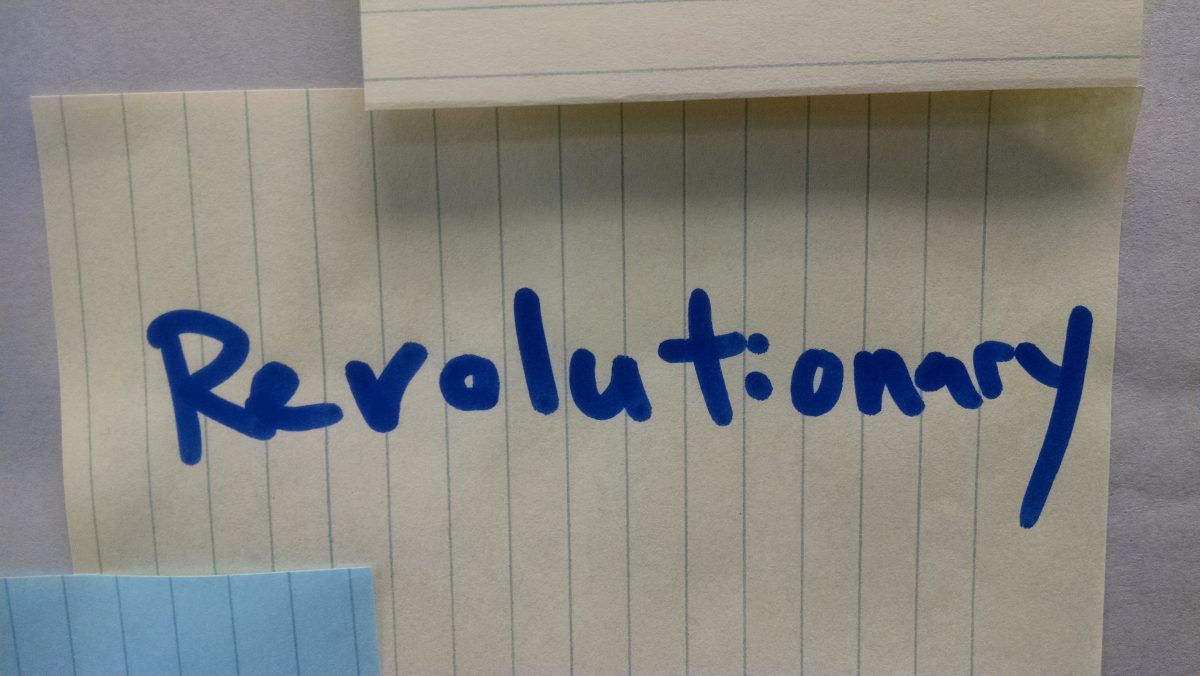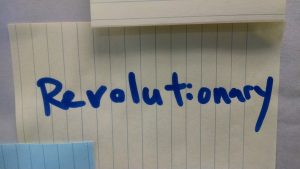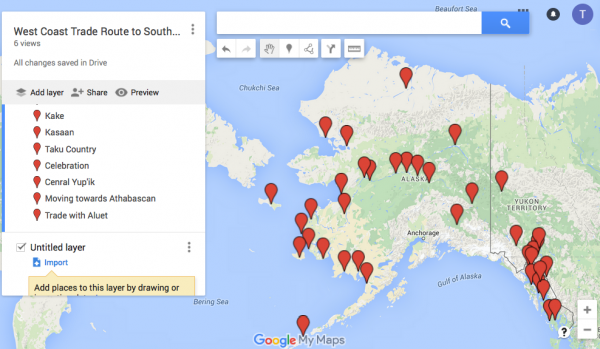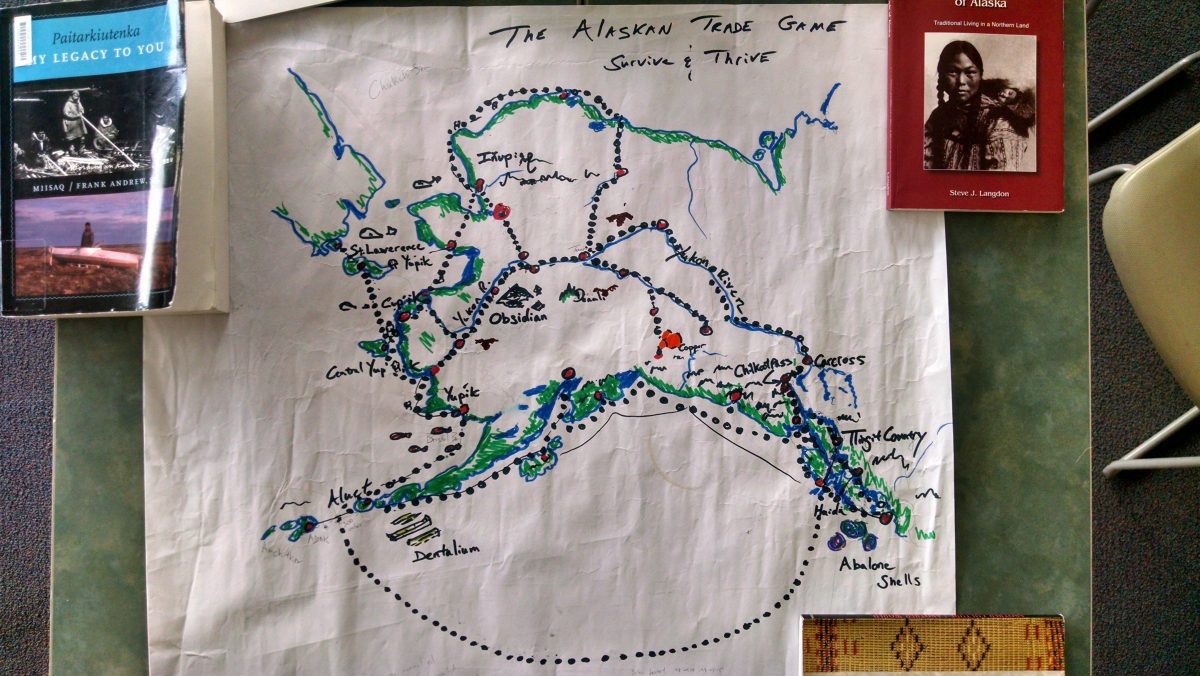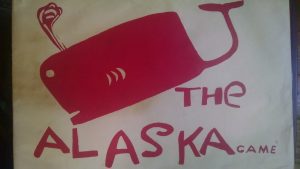| Honestly, it has been a really long time since I have been in school. When I think back to k-12, there aren’t too many teachers that stand out that resonate with this particular passage. I have to dip into my undergrad experience to find a teacher that evoked a passion for learning that went beyond the classroom. |
| To finish my requirements to minor in Native American Studies, I needed to complete Federal Indian Law and Policy. It was a weighty subject. The professor running the class was Dr. Andra New Holy. I had taken a few courses from her before and found the classes engaging and insightful. The Federal Indian Law and Policy course differed in that we were required to undertake a service project while studying the laws and policies that shaped lives of countless indigenous people of all tribes, clans and nations. |
| I learned of the ward relationship Native Americans have with the US government. The various tribes status as Domestic Dependent Nations. Studying the law that has made up the policies, greatly affected my psyche and motivated me to complete a service project that gave something back. It was probably extremely naive, but we made an attempt in the Montana state government to pass legislation to ban the use of pepper spray in youth correctional facilities because of the disproportionate number of incidents involving Native American youth. We traveled across the state to interview a juvenile parolee. He still bore the scars on his face from the repeated pepper spray incidents when we videotaped his interview which we later played as testimony at a Judiciary committee. We contacted the media and wrote the editors of papers. |
| Through all this, Dr. New Holy cheered us on and provided support. The project went far beyond school. We had been learning of all the injustices that our own government had been doling out since before it was a government. She brought us to a place where the struggles of over 500 years continued to manifest themselves. It should have been no surprise when the committee tabled the bill to ban the use of pepper spray in Montana youth correctional facilities. I choose Andra New Holy because she gave me the tools to push myself beyond the sphere of academia and into the harsh realities of a racist system where we made our heartfelt albeit feeble attempt to make a change for the better. I believe that is powerful teaching. |
Author: Tyler Thomas
Reflections on 680 Multicultural Ed
Words have a powerful effect on students. As a teacher, it is crucial to be aware of word choice. Words can cause great harm. There is no pulling a culturally insensitive word back from the universe once it has been uttered. A student could be forever damaged if he or she feels unwanted or stupid in the eyes of a teacher. If a student’s culture is overlooked throughout his or her schooling, a student will start to believe their culture has no place in the world. This could lead to despair, worthlessness and even suicide. David Katzeek spoke about the power of words when meet with us on the first day of class. He said, “every child is special,” and “you are an intelligent human being,” and “[child] has the power within them”. He translated these from Tlingit and had first heard them from his grandparents. There were so many precious gems to remember and apply to the classroom that had been put to use for thousands of years by the Tlingit People. The power of words can “lift up” a student to accomplish things they never thought possible.
As teachers, we must work hard to balance the perspectives the students receive, so a student’s culture is not overshadowed by the dominant culture’s world view. We must be honest with students about the hard realities that exist in our society. The more points-of-view we can see the world through, the deeper our understanding of the world can be. This is how we can empower all students to become great thinkers and doers of great deeds. Over the last three weeks, I have felt empowered. It has been the best feeling. If my students can feel the joy of learning that I am feeling, I will know we are on the right path.
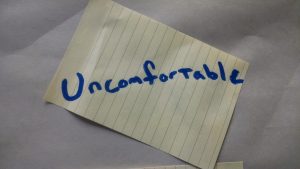 I choose whiteness, uncomfortable, and revolutionary from the word wall because together they tell a story of how we can begin to make changes in a flawed system. In order for there to be a revolutionary change in education, it is vital to understand that there exists a disparity between cultures. There is a whiteness that is most often not seen or recognized by white culture. The whiteness blinders must be removed in order to see the disadvantages that a multitude of cultur
I choose whiteness, uncomfortable, and revolutionary from the word wall because together they tell a story of how we can begin to make changes in a flawed system. In order for there to be a revolutionary change in education, it is vital to understand that there exists a disparity between cultures. There is a whiteness that is most often not seen or recognized by white culture. The whiteness blinders must be removed in order to see the disadvantages that a multitude of cultur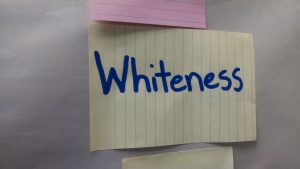 es face in our country. We must see that by design this system is made for an elitist white world aimed at controlling the masses through the fear of each other.
es face in our country. We must see that by design this system is made for an elitist white world aimed at controlling the masses through the fear of each other.
In order to change the system at root in education, we must embrace the uncomfortable topics such as racism. We must recognize that racism is still very much a part of our students lives. We must know that the very idea of race is a social construct. Discussing these issues and recognizing that they exist is the first step in deconstructing a destructive system. We cannot skirt around these often painful topics. We cannot fear stirring up emotions and tiptoeing around the fragile mindset of the privileged. This is the revolution that must happen for the world to be a better place. It will be uncomfortable and it should be. As Mahatma Gandi once said, “you must be the change you want to see in the world.”
My goal is to teach in a respectful, balanced manner. The classroom will be held to the same values. We will look to Traditional Values as a model for the classroom to follow. As a language arts/English teacher, we can apply Traditional Values to all the literature we read. By doing this, we can bring the mindset of a variety of people to any region and time period of the world
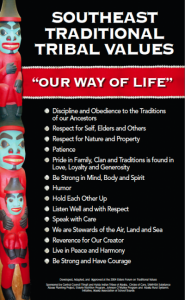 It is my understanding that my student practicum at Dzantik’i Heeni Middle School will be focusing their curriculum on world literature this coming year. By going far and wide, I want to keep subjects grounded and relevant on a local level. We can do this by reading/hearing stories based in Alaska time and space while running parallel to the world literature. It could be very powerful to recognize that while Homer wrote the Iliad and Odyssey, the Tlingit people and other indigenous people of Alaska were passing down Raven stories as well their pantheon of knowledge orally.
It is my understanding that my student practicum at Dzantik’i Heeni Middle School will be focusing their curriculum on world literature this coming year. By going far and wide, I want to keep subjects grounded and relevant on a local level. We can do this by reading/hearing stories based in Alaska time and space while running parallel to the world literature. It could be very powerful to recognize that while Homer wrote the Iliad and Odyssey, the Tlingit people and other indigenous people of Alaska were passing down Raven stories as well their pantheon of knowledge orally.
I plan to incorporate as much of the Tlingit language as possible into the classroom on a daily level. I realized that a Tlingit place name map could be a central resource to study the language. With the help of cultural bearers and Elders, we can learn how to make the sounds in order say the words properly. I want to challenge the way we make sounds and break the lazy habits that afflict most English speakers. Language holds the essence of a culture in my eyes. Even by making small attempts at speaking another language, a student can begin to understand another culture and have a broader world view.
Alaska Studies Reflection
Although this was a bizarre and challenging experience, in the end, it was an incredibly rewarding one. Not only did we discuss project-based learning and learn different approaches to evoking independent thinking, we lived it.
There were times I struggled with the amount of new technology features (a language onto itself), but realize these were tools being thrown in our direction to help. Sometimes it was too much and I did not have enough room to catch everything that was coming in my direction, especially as I was caught up thinking about the big picture of the project. I felt I had moments of “I won’t learn from you” and had to turn off the input button in my brain in order to keep my level of sanity and anxiety at a functional level. With the speed of the class and the daunting task of creating the iBook, I realized that I would have to pick up just enough to complete a given task. One step at a time. Within our small groups, there were experts in technology that coached me through seemingly easy tasks of tech navigation. Along the way, I became more comfortable with the basics and will look to pick up tech savvy skills that I can include in my classroom. I am living in the future after all.
There were also very knowledgeable team members of our region of study. As I read of Yup’ik concepts, I could ask Jimmy who is Yup’ik, “is this true?” He would either confirm with a “yes” and elaborate or offer a “I haven’t heard of that.” Sometimes a word would be from another language in the region and he would have his own line of inquiry to follow. Later as I wrote, the weight of these dialogues added an authority to my voice that I would not have if I had just paraphrased a passage in a book. As a group, we could challenge and enlighten each other. We debated over word choices in a respectful manner. Slowly the Alaska Studies aspect of Alaska Studies was seeping in and we were truly learning about Alaska. Before this project, I had slightly above average background knowledge of Alaska. Now, I feel have a personal connection to my understanding of Alaska and especially the West Coast region.
There was a method to the madness after all, and in the end I believe as class we created a pretty impressive product that will be a great jumping off point for other educators. The experience itself was not perfect, nothing is, but I believe this work in progress approach is important. I saw teaching theories put to practice, and recognize the value of awakening our own critical thinking. As they say, “Practice what you preach”.
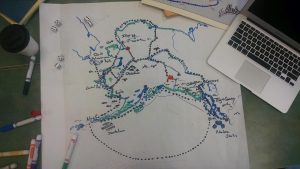 “Old School” meets “New School”
“Old School” meets “New School”
STAND- Knowledge derived from different systems
A culturally-responsive curriculum fosters a complementary relationship across knowledge derived from diverse knowledge systems.
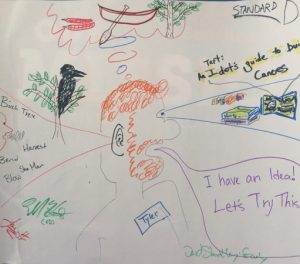 (Our poster of multi-knowledge systems converging to create a canoe)
(Our poster of multi-knowledge systems converging to create a canoe)
Our group focused on the combination of information being gathered from the oral tradition and from books. This standard translates quite well to a language arts/English class. Some the earliest stories/myths/biblical tales were passed down orally before being written down as text. Many of the great Raven stories have also been translated to the story book form. Raven stories have been written into plays then performed in many different productions in the theater making a full circle of oral tradition to text and back to a new form of oral story-telling.
It is pretty fascinating to realize how much information (crucial information) was passed down orally for thousands of years. Most of that tradition is nearly gone, and we are at key moment in time where languages are fighting for their survival. Some but not all can be preserved and passed down for future used through the main sources of media to record Elders. The next generation is stepping forward to safe guard their language like our cohort David Sheakley by learning to speak and teach Ling’it. I hope to bring what I can into the class room and encourage student to learn as much of the Ling’it language or any language for that matter that is vulnerable. It will be great to bring these standards to the classroom.
Survive Thrive Trade Lesson Plan for 680
Evolution of an Idea
I batted around the idea of making this a map building exercise where kids when create a poster of how they would get somewhere to acquire a given good. It was suggested that it could be turned into a game with a board, rules and such. I debated whether I should take the leap of developing guidelines, rules, a board and what not. I mentioned to my mom that I was thinking about maybe creating a board game as a lesson plan. She quickly dug out a rather large envelope with big red print that read: the ALASKA game which was created by Capital School back in 1972. It looked like a fun project and you could see the children’s input clearly in the action cards. With the Alaska game as a rough blue print to s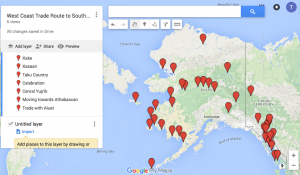 tructure my game, I literally traced the outline of the game board onto my own poster board and began tinkering and playing with my map. I also made a MyMap to help guide me and future players.
tructure my game, I literally traced the outline of the game board onto my own poster board and began tinkering and playing with my map. I also made a MyMap to help guide me and future players.
Culturally-knowledgeable students demonstrate an awareness and appreciation of the relationships and processes of interaction of all elements in the world around them.
The traditional values that are at the root of the gameplay are inspired from a traditional Yup’ik tall called “The Eye of the Needle” found in Father Michael Olesksa’s book Another Culture/Another World. In the story, a maurluq (grandmother) sends her tutgarluq(grandson) out on his first hunt. She asks him to return as soon as he has his first animal. Like many Yup’ik stories, the boy does not listen to his grandma and problems begin to mount. In the end, Maurluq saves the boy who has been transformed into a grotesque giant. A central message of the story– to listen to your elders with respect, share all food no matter how little, and respect the animals that have given themselves to you- became a key aspect to the game play and helped shape the rules and theme to the game itself. For example, players must make sure they reserve 2/3 of their catch for Maurluq and keep 1/3 for trading later in the game. Follow link below to view the full list of rules:
Survive Thrive Trade Rules:Game Play Final
I have slowly started to incorporate the Yup’ik language. In the rule book, I reference Maurluq as grandma once, then continue to refer to her in Yup’ik. Keeping words alive through use on an everyday level is key to building solid Cultural Standards. We should not simplify with translations back to English every time a Yup’ik word is seen. I have set the game in pre-contact Alaska to focus on the trade routes that the indigenous people created. After all, English was not spoken anywhere in the world for much of the time period this game takes place.
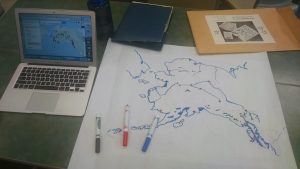 The process of this lesson plan has been very exciting. While sharing my lesson plan with a few cohorts, they have made some very interesting suggestions for future versions of this game that could also be linked to different lessons. The possibilities are vast. I also asked a team member to play an early version of the game to see how it would flow. The work in progress approach helped structure the game after just a few hands. We had a few rounds gathering resources on the hunt and slowly exploring the map. On his last roll, he decided to visit his father’s visit because he missed him. The game should retain some of this loose structure where players are traversing over the country and exploring waterways of their choosing. And though it does take place potentially thousands of years ago, I did not get bogged down with the details of images I used in MyMaps.
The process of this lesson plan has been very exciting. While sharing my lesson plan with a few cohorts, they have made some very interesting suggestions for future versions of this game that could also be linked to different lessons. The possibilities are vast. I also asked a team member to play an early version of the game to see how it would flow. The work in progress approach helped structure the game after just a few hands. We had a few rounds gathering resources on the hunt and slowly exploring the map. On his last roll, he decided to visit his father’s visit because he missed him. The game should retain some of this loose structure where players are traversing over the country and exploring waterways of their choosing. And though it does take place potentially thousands of years ago, I did not get bogged down with the details of images I used in MyMaps.
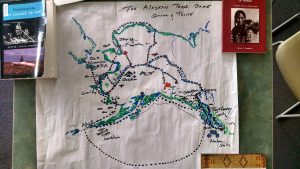 Part of the game, is seeing how it evolves. As a lesson, where can we see our class go with this? What would the group like to add that was missing? What time periods can we incorporate to bring to light an ever-changing cultural landscape? What resources were not included that should be? Who knows perhaps as a class they could create the next big role playing board/game or online gaming craze? Looking back at the Capital School’s big “the Alaska Game”, I see that it is more than possible.
Part of the game, is seeing how it evolves. As a lesson, where can we see our class go with this? What would the group like to add that was missing? What time periods can we incorporate to bring to light an ever-changing cultural landscape? What resources were not included that should be? Who knows perhaps as a class they could create the next big role playing board/game or online gaming craze? Looking back at the Capital School’s big “the Alaska Game”, I see that it is more than possible.
Click on the link below to access my lesson plan:
Alaska in Haiku
From my window, red-
roe colored salmon berries
ripe hold eyes from blog
Haiku can be found all over Alaska with all the depth to the nature in our backyard. I think it would be a lot of fun create a lesson plan that grows from Alaska in Haiku written by David Townsend Hoopes and Diana Rystbaek Tillian by reading examples from their book. Like this beauty: the winter moonlight/ the Shadow of the totem pole/ Shadow of the spruce.
After reading a few poems to give the students a baseline, we could briefly discuss the structure of the haiku’s 5-7-5 count of syllables and a bit of the Haiku’s origin from Japan namely from master Basho.
Then thinking as wandering poets, the class would go on a walk to observe nature. They could write on the spot or bring their ideas back to class to mull it over. If they felt constrained by the syllable count per line, it would be alright but encouraged to try to form and choose words that could bring their scene to the page.
As an another component to the exercise, students would exchange their poems later in the week, read them, then go on another walk seeking an image that matches what they feel inspired the haiku of their partner, and take a picture to accompany the haiku and create a Haiku Deck collection together as a class.
Because Alaska in Haiku follows the seasons, it could evolve into a year long activity. At the end of a year, the poets could publish their intimate portrait of their backyard in iBook.
Berries are ripper,/ now. the blog is finished, but/ rough draft sadly calls
-Tyler Thomas
p.s. in my excitement of the haiku lesson plan, I somehow forgot to capture a picture of Alaska in Haiku for the post. I will be needing a copy soon and will post accordingly. A special thanks to Kathy Nielson for sharing a few her favorites and reading a powerful story in class.
Beyond Heroes and Holidays- Jigsaw discussion
First of all I really enjoyed the forum of breaking down the text has a group- especially in our small groups. In our small groups, everyone had a chance to have their voice heard. It was the first time I truly heard certain cohorts articulate their thoughts on any subject matter let alone the heavy discourse of racism. By talking about these issues and our role within these shared experiences, we are walking on a path of much greater awareness. The 3 minute, 1 minute responses and “final word” was a great platform to truly listen in a respectful manner.
It was amazing how as an entire group we were able to break down a fairly weighty text in a short period of time. Individually reading the text took a few nights of head scratching, pondering and questioning a subject matter that is rather tricky and foreign to most of us- our own whiteness. As a group, I feel the concepts and the importance of understanding these concepts though uncomfortable (as it should be I learned) created a solid jumping off point to deconstruct and reconstruct the ever changing landscape of the classroom and our world in general.
